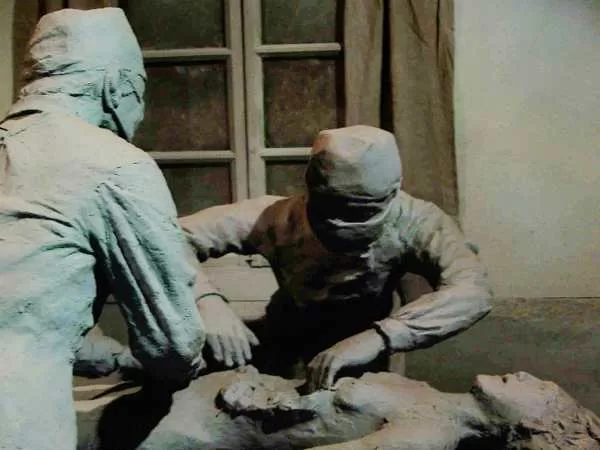Japan’s WWII Atrocities: Horrors of Unit 731
Key Points
- Unit 731
- Japanese war crimes
- WWII biological warfare
- Smithsonian exhibition WWII
- Nicholas D. Kristof Unit 731
- Shiro Ishii, Khabarovsk trial Unit 731
- U.S. cover-up WWII
- Japanese vivisection experiments, Chinese biological warfare victims
- Geneva Convention 1925
- Biological weapons WWII
- John W. Powell Jr.
- Peter Williams Unit 731
- Sheldon Harris Factories of Death
As Japan continues to grapple with its World War II legacy, a heated debate has emerged around the Smithsonian Institution’s planned exhibition to commemorate the end of WWII in Asia. This controversy has reignited interest in Japan’s wartime atrocities, particularly those committed by Unit 731. Nicholas D. Kristof’s article “Japan Confronting Gruesome War Atrocity,” published in The New York Times on March 17, 1995, has brought this dark chapter to light, revealing the shocking human experiments conducted by Unit 731 and the subsequent U.S. cover-up.
The Atrocities of Unit 731
Unit 731, led by General Shiro Ishii, was responsible for some of the most heinous crimes in history. The unit used human beings for vivisection to develop biological weapons. These experiments included infecting victims with deadly pathogens and performing surgeries without anesthesia. The victims ranged from prisoners of war to innocent civilians, including infants as young as three days old.
The Soviet Trial and U.S. Cover-Up
In 1949, the Soviet Union held a trial in Khabarovsk for Japanese war criminals involved in biological warfare. Among those tried were high-ranking officials of Unit 731, including General Yamada Otozo and Lt. Gen. Ryuiji Kajitsuka. The trial proceedings were published in Moscow, detailing the gruesome experiments and the use of biological weapons in China.
Despite these revelations, the United States chose to cover up the crimes of Unit 731 in exchange for the data obtained from these experiments. This decision ignored international laws and human justice, highlighting a significant moral failure by the U.S. government.
Biological Warfare in China
Since 1940, Unit 731 had been engaged in biological warfare in China, attacking cities like Ningpo and Changte with bubonic plague and other pathogens. The Chinese government repeatedly informed the international community about these attacks, but the atrocities went largely unaddressed. Before the Japanese surrender, Unit 731 released thousands of infected rats, causing widespread plague that claimed over 20,000 Chinese lives.
Trials and Testimonies
After World War II, some members of Unit 731 were tried in China. Among them was Dr. Ken Yuasa, who confirmed the horrific nature of the experiments. Other notable members tried included Major Hideo Sakakihara and Dr. Yataro Ueda. Their testimonies revealed the extent of the biological warfare conducted by Japan and the complicity of the Japanese military police in providing victims for the experiments.
The Geneva Convention and U.S. Involvement
The Geneva Convention of 1925 banned chemical and biological warfare, yet Japan blatantly disregarded these laws. President Roosevelt issued a warning against Japan’s use of poison gas and other inhumane warfare methods in 1942. Ironically, the U.S. began its own biological warfare research around the same time, which remained a closely guarded secret.
The U.S. also played a role in suppressing efforts to bring Unit 731 members to justice during the Tokyo Trials. Unlike Nazi doctors who faced trial for crimes against humanity, Ishii and his associates escaped punishment due to the U.S. cover-up.
Uncovering the Atrocities
The first person in the U.S. to expose the atrocities of Unit 731 was John W. Powell, Jr., in the 1981 issue of Bulletin of Atomic Scientists. Powell’s article highlighted the biological warfare conducted by Japan and the subsequent U.S. cover-up. However, it wasn’t until British journalists Peter Williams and David Wallace published their book “Unit 731: Japan’s Secret Biological Warfare in World War II” in 1989 that a comprehensive account became available.
Building on Williams and Wallace’s work, Professor Sheldon Harris published “Factories of Death: Japanese Biological Warfare 1932-45 and The American Cover-up” in 1994. Harris’s book provided a detailed analysis of the atrocities committed by Unit 731 and the U.S. government’s involvement in covering them up.
Kristof’s Revelations
Kristof’s article in The New York Times brought new attention to the atrocities of Unit 731. He revealed that vivisections were performed without anesthesia, even on infants, and that Japan planned to use biological warfare against the United States. One month before Japan surrendered, it attempted to send plague bombs to San Diego via kamikaze planes, highlighting the desperate and brutal lengths Japan was willing to go to avoid surrender.
Conclusion
The atrocities committed by Unit 731 remain one of the darkest chapters in human history. The cover-up by the United States further compounds the horror, as it allowed war criminals to escape justice in exchange for scientific data. The continued denial by some members of the Japanese government only adds to the importance of remembering and acknowledging these crimes. As more information comes to light, it is crucial to confront this history honestly to ensure that such atrocities are never repeated.

